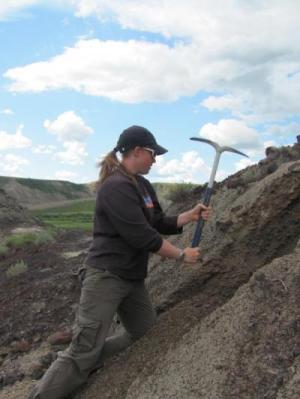The dry, barren prairie around Alberta’s Drumheller area was once a lush and subtropical forest on the shores of a large inland sea, with loads of wetlands inhabited by dinosaurs, turtles, crocodiles and small mammals.
But that changed about 71-million-years ago, according to a new study by researchers Annie Quinney and Darla Zelenitsky in paleontology at the University of Calgary. The researchers’ calculations show that drastic climate change occurred during a five-million-year period in Alberta’s badlands. At this time, the wetlands dried up and the warm humid climate was interrupted by a sudden cool, drying spell.
The study of ancient climate change is important as it helps researchers understand the impact sudden heating and cooling may have had on plants and animals.
“This was a time of change in Alberta, the wetlands disappeared as the inland sea retreated and the climate cooled,” says Quinney, a former master’s student in the Department of Geoscience. She led the study recently published in the journal Palaeogeography, Palaeoclimatology, Palaeoecology, which was part of her master’s degree in the Department of Geoscience.
Dramatic climate change was previously proposed to be responsible for the disappearance of turtles 71-million-years ago, because they were considered to be “climate-sensitive” animals. Results of this research, however, show that the disappearance of turtles came before the climate cooled and instead closely corresponds to habitat disturbances, which was the disappearance of wetlands.

This shows Annie Quinney excavating ancient soils in 70 million-year-old rocks in the Drumheller badlands. (Credit: Credit: Kohei Tanaka, University of Calgary.)
“The big surprise is that some animals, for example turtles, appeared to be more sensitive to habitat disturbances than to climate changes. Therefore, even if climatic conditions are ‘ideal,’ turtles may disappear or may not recover unless habitats are just right,” says Quinney.
Quinney and supervisors Zelenitsky, assistant professor in the Department of Geoscience, and François Therrien of the Royal Tyrrell Museum in Drumheller studied ancient soils preserved in the rocks in the Red Deer River valley near Drumheller that were deposited 72 to 67 million years ago and record information about the past climate and environments.
Researchers calculated precipitation and temperature levels over a five-million year interval and during that time, temperature and precipitation dropped over a few thousand years, and that cooler interval lasted for 500,000 years.
“By studying the structure and chemistry of ancient soils, we were able to estimate the ancient temperature and rainfall that prevailed when those soils formed millions of years ago,” says Quinney, who is now completing a PhD at Monash University in Australia on a full scholarship.



 March 17th, 2013
March 17th, 2013  Riffin
Riffin  Posted in
Posted in  Tags:
Tags: 